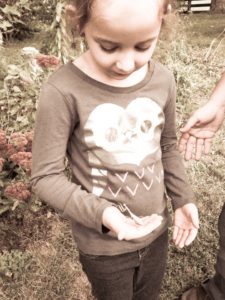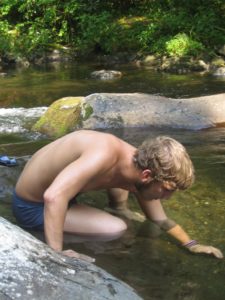By Wren Smith
 We are so excited that Richard Louv is coming to Bernheim this Saturday, July 16, 2016. Louv is the author of the acclaimed book, Last Child in the Woods:Saving our Children from Nature Deficit Disorder, and other related books and articles. Many of our Bernheim Volunteer Naturalists will be on hand before, during, and after the lecture to share some of their passion for nature. It is fitting that they be there since naturalists play an important part in reducing nature deficit disorder in adults as well as children.
We are so excited that Richard Louv is coming to Bernheim this Saturday, July 16, 2016. Louv is the author of the acclaimed book, Last Child in the Woods:Saving our Children from Nature Deficit Disorder, and other related books and articles. Many of our Bernheim Volunteer Naturalists will be on hand before, during, and after the lecture to share some of their passion for nature. It is fitting that they be there since naturalists play an important part in reducing nature deficit disorder in adults as well as children.
Perhaps, you are wondering, “what is a naturalist, anyway”?
 Several years ago while attending a conference in Charleston, South Carolina, I heard Rudy Mancke, naturalist, writer, and the creative force behind the acclaimed public television show, NatureScene, say that a naturalist is someone who studies the world around them and is in awe of what they find there. Of all the definitions of the word “naturalist”, I like Mr. Mancki’s the best. I love this definition for what it does, and what it doesn’t suggest. First, there is the implication that something is required of us. Yes, study! We prepare ourselves to enter into a relationship, one that, like all healthy relationships, is reciprocal in nature. We aren’t merely drinking in the scenery, we are opening our hearts and preparing our minds to give the necessary time, attention, and care.
Several years ago while attending a conference in Charleston, South Carolina, I heard Rudy Mancke, naturalist, writer, and the creative force behind the acclaimed public television show, NatureScene, say that a naturalist is someone who studies the world around them and is in awe of what they find there. Of all the definitions of the word “naturalist”, I like Mr. Mancki’s the best. I love this definition for what it does, and what it doesn’t suggest. First, there is the implication that something is required of us. Yes, study! We prepare ourselves to enter into a relationship, one that, like all healthy relationships, is reciprocal in nature. We aren’t merely drinking in the scenery, we are opening our hearts and preparing our minds to give the necessary time, attention, and care.
What may start out as causal affair, blossoms into a full-fledged commitment. We fall in love. We become passionate in our desire to understand more about our beloved. We take time for the intimacy needed to discover the treasures previously hidden in plain sight. We may find ourselves reading odd but exquisite journals on natural history subjects that can range from bryology, to zoology; from comparative anatomy to plant physiology. We may begin to carry field guides, notebooks, sketch pads, magnifiers, binoculars, plant presses, sweep nets, and various other accouterments of the field. We may research online, bookmarking credible and useful sites.
But mostly we spend a lot of time tromping about in woodlands, creeks, meadows, marshes, weed lots, or strolling attentively along lake and sea shores. We are awed and delighted by discovery. We see a painted bunting, hear the haunting spiraling song of a veery echoing from the valley, or find a spicebush caterpillar in its ingenious disguise, and our eyes widen in wonder. Or sometimes we stand in the place where history was made, perhaps where civil rights were defended, and the same sense of awe captures our imaginings, and moves us to learn more, sometimes to be more.
As our love grows, so does our desire to protect that which we love. Make no mistake, this is not a thornless rose. This love affair, like any passion, supplies its share of heart break. The disappointment of the naturalist who realizes that the meadowlarks once a familiar sight and sound have nearly disappear from his or her rural landscape…or watches as a woodland containing yellow lady slipper orchids is destroyed in the name of development exemplifies this heart break.
Mankee ‘s definition does not suggest that humans are separate from nature. He invites us to study the world as a part of it. From this perspective, human history, culture, and the rest of nature create the matrix that inspires and informs a more holistic approach to loving and protecting the planet.
Yes, Rudy Mancke, I couldn’t agree more. Being a naturalist involves studying the world around us, and being in awe of what we find there. What better defense against nature deficit disorder!

